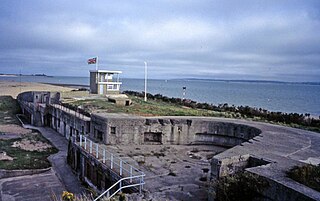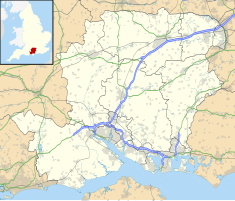
Gosport is a town and non-metropolitan borough on the south coast of Hampshire, South East England. At the 2011 Census, its population was 82,662. Gosport is situated on a peninsula on the western side of Portsmouth Harbour, opposite the city of Portsmouth, to which it is linked by the Gosport Ferry. Gosport lies south-east of Fareham, to which it is linked by a Bus Rapid Transit route and the A32. Until the last quarter of the 20th century, Gosport was a major naval town associated with the defence and supply infrastructure of Her Majesty's Naval Base (HMNB) Portsmouth. As such over the years extensive fortifications were created.

Shoreham Redoubt is a historical military defensive structure and scheduled monument at the entrance to Shoreham harbour, at the mouth of the River Adur in West Sussex, England. It was planned in the 1850s during a period of political alarm in the United Kingdom. Construction of the fort was completed in June 1857 at a cost of £11,685. The design is similar to that of Littlehampton Fort, which had been built in 1854.

Crownhill Fort is a Royal Commission Fort built in the 1860s in Crownhill as part of Lord Palmerston's ring of land defences for Plymouth. Restored by the Landmark Trust, it is now home to several small businesses, museums, exhibitions and a holiday apartment sleeping up to eight people. The Fort is open to the public on the last Friday of each month and hosts tours for local schools and societies at other times.

The Royal Commission on the Defence of the United Kingdom was a committee formed in 1859 to enquire into the ability of the United Kingdom to defend itself against an attempted invasion by a foreign power, and to advise the British Government on the remedial action required. The appointment of the Commission had been prompted by public concern about the growing military and naval power of the French Empire and was instigated by the Prime Minister, Henry Temple, 3rd Viscount Palmerston, who came to be closely associated with the project. In the following year, the Commission's report recommended a huge programme of fortification to defend the country's arsenals and naval bases. Many of the recommendations were acted upon; however, the great expense, the length of time taken to complete the various works and their perceived usefulness were all subjects of critical political, press and public debate.

Fort Gilkicker is a historic Palmerston fort built at the eastern end of Stokes Bay, Gosport, Hampshire England to dominate the key anchorage of Spithead. It was erected between 1863 and 1871 as a semi-circular arc with 22 casemates, to be armed with five twelve-inch guns, seventeen ten-inch guns and five nine-inch guns. The actual installed armament rather differed from this. In 1902 the RML guns were replaced by two 9.2-inch and two six-inch BL guns, and before the First World War the walls were further strengthened with substantial earthwork embankments. The fort was disarmed in 1956 and used for storage until 1999, and is currently in a state of disrepair.

Fort Fareham is one of the Palmerston Forts, in Fareham, England. After the Gosport Advanced Line of Fort Brockhurst, Fort Elson, Fort Rowner, Fort Grange and Fort Gomer had been approved by the Royal Commission on the Defence of the United Kingdom a decision was made to build an outer line of three more forts two miles in advance of the Gosport Advanced Line. Of these three projected forts only Fort Fareham was built due to the need to cut costs. It acted as a hinge between the forts on Portsdown Hill and those of the Gosport Advanced Line, filling the gap at Fareham. It has been a Grade II Listed Building since 1976.

Fort Nelson, in the civil parish of Boarhunt in the English county of Hampshire, is one of five defensive forts built on the summit of Portsdown Hill in the 1860s, overlooking the important naval base of Portsmouth. It is now part of the Royal Armouries, housing their collection of artillery, and a Grade I Listed Building.

Fort Brockhurst is one of the Palmerston Forts, in Gosport, England and a Scheduled Ancient Monument. It is now an English Heritage property.

Fort Gomer was one of the Palmerston Forts, in Gosport, England, the southernmost and first-built Polygonal fort in the defence line to the west of Gosport. It was located on land immediately to the west of the present Gomer Lane. Fort Gomer was the most southerly fort in the line of five which formed part of the ‘Sea Front and Spithead Defences’, Inner Line, Land Front, Left Flank. This line of forts was later known as the Gomer-Elson Line or 'Gosport Advanced Line' This consisted of, from south to north, Fort Gomer, Fort Grange, Fort Rowner, Fort Brockhurst and Fort Elson. An inscription above the main entrance through the barrack block read `Erected AD 1853’. The fort was almost complete before work began on Fort Elson in 1855. The estimated cost of Fort Gomer was £92,000 in 1869.

Browndown Battery, also referred to erroneously in some sources as Browndown Fort, is a former military coastal defence fortification and base on the Southern shoreline of England in the county of Hampshire. First erected in the mid-1840s, the battery was continuously modified until disarmed in 1905/6. It has been a Grade II Listed Building since 1983.

A ditch in military engineering is an obstacle, designed to slow down or break up an attacking force, while a trench is intended to provide cover to the defenders. In military fortifications the side of a ditch farthest from the enemy and closest to the next line of defence is known as the scarp while the side of a ditch closest to the enemy is known as the counterscarp.

Puckpool Battery is a battery located at Puckpool Point, close to the town of Ryde on the Isle of Wight. It is one of the many Palmerston Forts built on the island to protect it in response to a perceived French invasion. Construction of the battery began in 1863 and was completed by March 1865.

Redcliff Battery is a battery located to the west of the Culver Cliffs and east of Yaverland on the Isle of Wight, England. It is one of the many Palmerston Forts built on the island to protect it in response to a perceived French invasion. Construction of the battery began in April 1861 and was complete by September 1863 at a cost of £4,776. Most of it has fallen into the sea. Only small amount left May 2020

Bembridge Fort is a fort built on the highest point of Bembridge Down close to the village of Bembridge on the Isle of Wight, England. It is one of the many Palmerston Forts built around Portsmouth during the period of the Second French Empire, as a safeguard against a perceived threat of French invasion by Napoleon III.

Fort Rowner is one of the Palmerston Forts, in Gosport, England.

Lumps Fort is a disused fortification built on Portsea Island as part of the defences for the naval base at Portsmouth.

The Stokes Bay Lines were part of the great Victorian fortification of Portsmouth Harbour under Lord Palmerston. In 1857 Major Jervois had proposed a complex system of moats (ditches), ramparts and batteries to close off the gap between the new fort at Fort Gomer, and the earlier fort at Fort Gilkicker, and Fort Monckton. This defensive moat was to become the ‘Stokes Bay Lines’.

Fort Grange is one of the Palmerston Forts, in Gosport, England. After Gomer and Elson forts had been approved in 1852, further consideration led to a decision to fill the gap between them by three more forts, and Grange is the most southerly of the three. Work began in 1858 and it was completed in 1863.
Defence Munitions Gosport is a defence munitions site which is situated on the south western shores of Portsmouth harbour, southeast of Fareham in Hampshire. The site occupies about 470 acres. DM Gosport facilities include two Integrated Weapon Complexes (IWCs), 24 processing rooms and 26 explosives stores. The site employs some 270 staff.


















